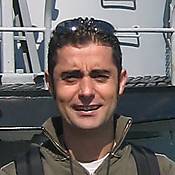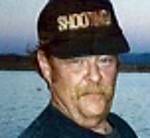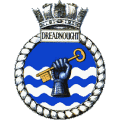You are viewing the archived version of the site.
Go to modelshipwrights.com for the current dynamic site!
Go to modelshipwrights.com for the current dynamic site!
1⁄700U.S.S. Brooklyn CL-40
7
Comments
The last step of the construction was the deck-edge railings. The forward rails are pre-curved to compensate for the bow sheer, and these fit perfectly. I tacked the rail at the bow and slowly worked my way aft, applying a thin bead of superglue to the interior of the joint as I progressed. I measured and cut the midships and stern sections, and blended the horizontal portions of the rail into the protruding gun tubs along the deck edge. After a few touchups here and there, I gave the Haze Gray areas a thin wash of Payne’s Gray oils, and then sprayed the model with Testor’s DullCote.
Since the vast majority of 1/700 ship models are waterline, having a half-hulled model on a plain wooden base simply wouldn’t suffice, so I painted the top of the base with a lumpy, half-used bottle of Tamiya medium blue. This provided the base color for the “water” that the model would sit in. The next step was a generous amount of Liquitex Acrylic Gel Medium, spread out over the base and around the hull. Gel Medium is used by artists to thicken acrylic paints, to give them the same consistency as oils, but without the long drying times. It has the consistency of toothpaste, and dries clear as it settles. Once I was satisfied with the height and shape of the waves in my “water”, I inserted the completed tugboat alongside the Brooklyn’s bow. I allowed the gel medium to set for 24 hours, and then applied a wash of Vallejo Dark Prussian Blue, followed by a brushed-on coat of Future Floor Polish tinted with Games Workshop’s blue ink. This gives the relatively thin layer of gel medium a deeper, transparent look. I finished up by dry-brushing some whitecaps and a wake at tugboat’s stern.
A hearty thanks to Mr. Bill Grunter of Pacific Front Hobbies for providing the kit for this story. Check out his online shop at www.pacificfront.com.
details....
Originally, I had intended to model the Brooklyn underway, throwing a nice bow wave and wake. I realized, though, that the base I chose wasn’t large enough to effectively show a full wake. I thought about modeling her at anchor, but that was pretty boring, so I decided to add a neat little tugboat I bought at the IPMS Nationals in Kansas City a couple of years ago. The Battlefleet Models tug is a simple affair, only two resin parts, some brass rod for the radio masts, and a section of photo-etched railing. I built the tugboat in under an hour, and positioned it where I thought it looked best.Since the vast majority of 1/700 ship models are waterline, having a half-hulled model on a plain wooden base simply wouldn’t suffice, so I painted the top of the base with a lumpy, half-used bottle of Tamiya medium blue. This provided the base color for the “water” that the model would sit in. The next step was a generous amount of Liquitex Acrylic Gel Medium, spread out over the base and around the hull. Gel Medium is used by artists to thicken acrylic paints, to give them the same consistency as oils, but without the long drying times. It has the consistency of toothpaste, and dries clear as it settles. Once I was satisfied with the height and shape of the waves in my “water”, I inserted the completed tugboat alongside the Brooklyn’s bow. I allowed the gel medium to set for 24 hours, and then applied a wash of Vallejo Dark Prussian Blue, followed by a brushed-on coat of Future Floor Polish tinted with Games Workshop’s blue ink. This gives the relatively thin layer of gel medium a deeper, transparent look. I finished up by dry-brushing some whitecaps and a wake at tugboat’s stern.
in closing...
The detail found in this newer-generation resin kits are incredible, easily as detailed as their larger, 1/350 scale brethren. As much as I love this diminutive model, building something this small and detailed was truly a challenge for me. I guess all these big-scale models have dulled my fine motor skills. Nevertheless, I’m very pleased with the results of my efforts. I guess I still have what it takes to be a Renaissance Modeler!A hearty thanks to Mr. Bill Grunter of Pacific Front Hobbies for providing the kit for this story. Check out his online shop at www.pacificfront.com.
 The bridge areas of the Brooklyn. Perhaps the most-difficult part of painting involves getting a straight demarcation line between the colors.
The bridge areas of the Brooklyn. Perhaps the most-difficult part of painting involves getting a straight demarcation line between the colors. No, those aren’t large pliers, those are small tweezers holding an even-smaller 1/700 40mm AA gun.
No, those aren’t large pliers, those are small tweezers holding an even-smaller 1/700 40mm AA gun. The searchlight platform is small, complex, and highly detailed. The structure is made up of a dozen parts, and the scaffold structure required multiple bends.
The searchlight platform is small, complex, and highly detailed. The structure is made up of a dozen parts, and the scaffold structure required multiple bends. The searchlight platform is small, complex, and highly detailed. The structure is made up of a dozen parts, and the scaffold structure required multiple bends.
The searchlight platform is small, complex, and highly detailed. The structure is made up of a dozen parts, and the scaffold structure required multiple bends. With the small parts installed, the final details include the most-fragile of the photo-etched parts. The fire control radars, yardarms, and rigging are easily broken, so saving them for last is key to a successful build
With the small parts installed, the final details include the most-fragile of the photo-etched parts. The fire control radars, yardarms, and rigging are easily broken, so saving them for last is key to a successful build Here’s a really large X-acto knife…no, wait, that’s a really small Kingfisher and catapult.
Here’s a really large X-acto knife…no, wait, that’s a really small Kingfisher and catapult. The construction is complete, now it’s time to put the ship into its environment.
The construction is complete, now it’s time to put the ship into its environment.
Comments
Hi Jeff (again)
I really like reading out your article and it was interesting to see a different way of building these small "beasts" - perhaps that's why yours are better than mine
Flawless all the way, good water environment, nice touch with the BFM big tug, but... there are missing some crew members! IMHO if you are going to make a particular scene like this with the tug, you have to make it manned
Thanks for sharing it and welcome back to 1/700
Rui
JUL 07, 2008 - 04:47 AM
Adding the tug just made a good build even better. Just those little extras change the whole scene.
Thanks for sharing!
JUL 07, 2008 - 06:11 AM
Thanks for sharing more views of your excellent build Jeff. Always interesting stuff coming off of your bench, no matter what the scale. Looking forward to more.
JUL 07, 2008 - 11:20 AM
Fantastic model Jeff!!... Very clean model, well built and painted. The only suggestion I have (and I'm sure you would of done it eventually) would be to give the base edge a coat of paint or stain.
thanks for sharing,
Frank
JUL 08, 2008 - 08:23 AM
Ahoi Jeff!
good to see you building a ship model again!
Great looking build all round!
-agree with Rui that some crew populating the scene would add to the realism!
Jim Baumann
JUL 19, 2008 - 12:32 AM
Copyright ©2021 by Jeff Herne. _OPINIONS Model Shipwrights, KitMaker Network, or Silver Star Enterrpises. Images also by copyright holder unless otherwise noted. Opinions expressed are those of the author(s) and not necessarily those of Model Shipwrights. All rights reserved. Originally published on: 2008-07-07 00:00:00. Unique Reads: 9491













